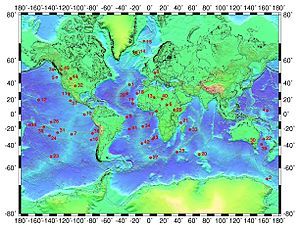Tristan hotspot facts for kids
The Tristan hotspot is a special place deep under the Atlantic Ocean. It's like a super-hot spot that causes volcanoes to form. This hotspot helped create the island of Tristan da Cunha. It also formed a long underwater mountain range called the Walvis Ridge. This ridge is on the African Plate, which is one of Earth's giant moving pieces.
Contents
What is the Tristan Hotspot?
A hotspot is a place where hot rock from deep inside Earth rises to the surface. This hot rock, called magma, can melt through the Earth's crust. When it breaks through, it creates volcanoes. The Tristan hotspot is responsible for many volcanoes in the southern Atlantic Ocean.
How Did the Hotspot Form Land?
Scientists believe the Tristan hotspot is linked to huge lava flows. These flows created large areas of volcanic rock. These areas are known as the Paraná and Etendeka flood basalt provinces. They formed when the South Atlantic Ocean first started to open up.
The Tristan hotspot and the Gough hotspot are two key parts of this volcanic system. They helped create the Walvis Ridge on the African plate. They also formed the Rio Grande Rise on the South American plate. This started about 129 to 133 million years ago. That's when the Paraná and Etendeka lava flows happened. Scientists are still discussing if Tristan and Gough are two separate hot spots or part of one big system.
Some researchers, like Fairhead and Wilson (2005), have a different idea. They think the Walvis Ridge wasn't made by a deep hotspot. Instead, they suggest that changes in the stress of the moving African and South American plates caused it. These changes might have triggered volcanic activity along the Mid-Atlantic Ridge.
Other studies, like O'Connor et al. (2012), found something interesting. Hotspot trails in the eastern South Atlantic started forming at the same time. This was about 41 to 44 million years ago. These trails include Tristan, Gough, Discovery, Shona, and possibly Bouvet. Older underwater mountains in this area formed differently. They were created where the ocean floor was spreading apart. They were not made by hotspots.
These hotspots in the eastern South Atlantic formed in special areas. These areas are called plume generation zones (PGZs). They are part of the African large low seismic velocity province (LLSVP). LLSVPs are stable structures deep inside Earth. Most of Earth's hotspots and large lava flows can be traced back to these PGZs. The Tristan-Gough hotspot was unique. It was the only African hotspot located where plates were pulling apart. This allowed it to form a long trail of volcanoes.
Hotspots and Ancient Animals
The Tristan hotspot system might have played a role in how ancient animals moved around. Scientists have looked at the DNA of chimpanzees and humans. They found that our ancestors might have split from chimpanzee ancestors about 10.5 to 13 million years ago.
Another study looked at monkeys. It suggested that New World monkeys (from the Americas) and Old World monkeys (from Africa and Asia) split about 70 million years ago. This study also thought that Old World monkeys first appeared in South America. Then, they moved to Africa.
How could monkeys cross a huge ocean? One idea is that the Rio Grande-Walvis Ridge system was once above sea level. It might have formed a chain of islands across the South Atlantic. This could have happened between 65 and 70 million years ago. These islands might have acted like stepping stones. They would have allowed ancient primates to travel across the ocean. However, other scientists think it was more likely that animals floated across on natural rafts of plants.
Another clue comes from a fossil bird called Lavocatavis. This was a flightless "terror bird." It was found in Algeria, in Africa. This is surprising because terror birds are mostly found in South America. This fossil suggests that some animals might have "island hopped" across the ocean.
See also
 In Spanish: Punto caliente de Tristán de Acuña para niños
In Spanish: Punto caliente de Tristán de Acuña para niños


